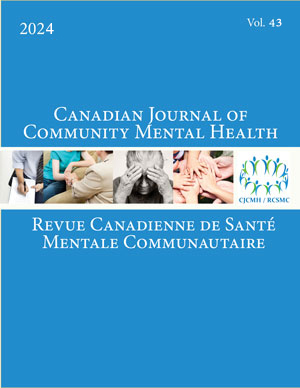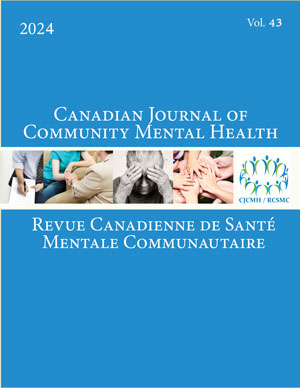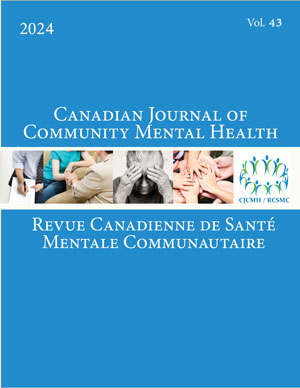Volume 22 • Number 1 • April 2003
OPEN ACCESS
As part of a participatory action research project, we surveyed 300 psychiatric consumers/survivors from southwestern Ontario regarding their housing preferences and housing satisfaction. We found that, while 79% of the sample preferred independent living, 76% were living in some other type of setting (e.g., temporary shelter, supportive housing, sheltered care). Those living in temporary shelters reported the lowest levels of housing satisfaction, and those who were living in the type of housing that they preferred had the highest levels of housing satisfaction. This information is being used by stakeholder groups involved in the project to help build the capacity of the community to provide the types of housing that are preferred by consumers/survivors.
OPEN ACCESS
The purpose of this qualitative paper is to describe, from the consumers' perspective, the complex factors involved as persons with serious mental illness grow older in the community. The results consisted of seven major themes subsumed under three categories. The first category, across the lifespan, included three themes: (a) older but wiser, (b) one day at a time, and (c) echoes from the past. The second category, factors impeding participation in the life of the community, also included three themes: (a) on the outside looking in, (b) walk a mile in my shoes, and (c) without a voice. The final category, factors which enhance participation in community life, included only one theme: meaningful activities and productive roles. Findings suggest that service providers must actively involve consumers as primary members of the rehabilitation team to deliver effective, individualized services which are designed around the particular future needs and resources of older persons with serious mental illness. Furthermore, stigma reduction through advocacy and education at the community level must be strengthened.
OPEN ACCESS
Les programmes de réinsertion socioprofessionnelle offerts par 2 centres de la région de Québec accueillant des personnes présentant des troubles mentaux graves ont fait l'objet d'un examen après 10 années d'activité. Une étude d'une durée de 10 mois sur un échantillon de 30 usagers et usagères, ayant vécu depuis au moins 6 mois dans la communauté et dont la santé mentale est stable, a permis de constater des gains: meilleure estime de soi, capacité accrue à affronter les stresseurs quotidiens, développement d'une meilleure qualité de vie et acquisition de compétences professionnelles. En conclusion sont discutées les visées de ces programmes en matière d'intégration en emploi.
OPEN ACCESS
This study gathered data from adolescent girls in four regions (Ottawa, North Bay, Toronto, Windsor) concerning key issues in the prevention of depression in young women. Using a participatory methodology, a team of young women worked with researchers to design and conduct focus groups with 48 adolescent girls across Ontario. Major themes emerging from the focus group data fell into five categories: (a) symptoms, (b) contributing factors, (c) alleviating depression, (d) prevention, and (e) barriers to receiving help. These findings should be considered when designing programs targeting depression in young women in order to maximize the accessibility and effectiveness of such initiatives.
OPEN ACCESS
On September 2nd, 1998 Swissair Flight 111 crashed in Saint Margarets Bay, Nova Scotia. Surrounding coastal communities were immediately transformed into disaster response sites. Sixteen community health professionals were interviewed that identified several types of individual and community exposure, including exposure to human remains. The interviews revealed that the coastal communities have responded with silence and stoicism. This silence has been viewed by some health professionals as resilience. The interface of a major disaster, community silence, low help-seeking behaviours, and limited disaster health responses raises the critical question whether this is a profile of resilience or a community silently enduring.
OPEN ACCESS
Le projet ontarien «Partir d'un bon pas pour un avenir meilleur» («Better Beginnings, Better Futures») vise la mise en œuvre de programmes de prévention dans le domaine de l'adaptation comportementale et affective d'enfants âgés de moins de 8 ans vivant dans 8 communautés socio-économiquement défavorisées. La communauté de Cornwall est la seule communauté francophone participant au projet. Le présent article s'intéresse aux effets à court terme du projet Partir d'un bon pas de Cornwall, suite aux 4 premières années de sa mise en œuvre. Les résultats soulignent une augmentation des comportements prosociaux et une diminution des problèmes affectifs et comportementaux chez les enfants. Ils soulignent également une amélioration significative de leur nutrition et des soins de santé qu'ils reçoivent. Les écoles visées par le projet ont aussi connu une dimi-nution du nombre d'enfants inscrits en enfance en difficulté, principalement dans les domaines des problèmes de comportement et des difficultés d'apprentissage. Cependant, les programmes offerts n'ont pas été en mesure de produire des effets significatifs sur le développement cognitif et scolaire des enfants.
OPEN ACCESS
To evaluate the processes and outcomes of a short-term shelter, both quantitative and qualitative data were gathered via participant observation, focus group interviews with shelter staff and residents, and individual interviews with a sample of 40 young women who had been homeless prior to using the shelter. The process evaluation showed that the shelter staff strived to utilize an empowerment philosophy in their relationships with residents, but that there were many challenges to implementing this philosophy. The outcome evaluation showed that, at a 3-month follow-up, the participants reported significant improvements in housing, income, independence, and life satisfaction, but most continued to experience poverty and a number of other difficulties. The results were discussed in terms of the implications for future research and the value and limitations of shelters for dealing with homeless youth. The need for more sustained and comprehensive program interventions and supportive social policies was underscored.
OPEN ACCESS
One hundred and eighty persons with serious mental illness (SMI) in eastern Ontario, receiving services from assertive community treatment teams in Brockville and Kingston were interviewed about substance use. Data were compared to survey findings for the Ontario population. Tobacco use was higher among both men and women in the SMI sample, but use of alcohol and drugs in the past 12 months was lower than population data. The frequency of alcohol use was significantly greater than drug use among the SMI sample.










